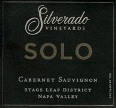Silverado Vineyards, Napa Valley – Stags Leap District, Cabernet Sauvignon “SOLO” 2013 ($125): Stags Leap District is one of Napa Valley’s most iconic sub-appellations. Acclaim began in the early 1960s with the success of Heitz Cellars’ vineyard-designated Fay Cabernet Sauvignon produced from grapes grown by Nathan Fay, who pioneered the planting of Cabernet Sauvignon vines in the District. The success of Stag’s Leap Wine Cellars’ 1973 Cabernet Sauvignon in the “Judgement of Paris” tasting in 1976 raised the area’s profile further. In more recent times,  outstanding wines from wineries such as Clos du Val and Shafer Vineyards brought even more recognition.
outstanding wines from wineries such as Clos du Val and Shafer Vineyards brought even more recognition.
Silverado Vineyards, the subject of this column, was one of the early players in the Stags Leap District. In 1978, its founders, Diane Disney Miller and Ron Miller, purchased the 93-acre Silverado Vineyard, one of the first three Cabernet Sauvignon vineyards in the District. In 1984, the newly-constructed winery released its inaugural Cabernet Sauvignon wine, the 1981. Three years later, winemaker Jack Stuart would be named Winemaker of the Year by the International Wine and Spirits Competition (IWSC) in London.
In 1998 Jon Emmerich became only the second winemaker in the winery’s history. To mark the winery’s 25th anniversary, in 2006 he introduced SOLO, an all-Cabernet Sauvignon wine sourced entirely from the estate’s historic Silverado Vineyard. The vines for this wine represent a single clone, technically named Cabernet Sauvignon FPS 30 and known as the Silverado Heritage Clone; it is one of only three Cabernet Sauvignon clones recognized as a heritage clone by the University of California at Davis, and the only one from the Stags Leap District.
In other words, Silverado Vineyards Cabernet Sauvignon SOLO from Stags Leap District is a wine with an impressive pedigree. The 2013 SOLO stunningly does justice to that pedigree.
The wine’s aroma is deep and pure and gentle, with notes of blackcurrants, dried herbs, tobacco, cedar and perfume. The wine enters your mouth dry and soft, full of ripe, richly-textured dark fruit. Tannins emerge to frame the soft fruit and give definition to the wine. You might wonder whether the fruit is already too open and might not have the staying power for the developmental timeline that the tannins suggest — but then you see how concentrated the fruit actually is. The magic of this wine is that special fruit, which is so available and yet has the inherent integrity to hold up to the tannin and sustain the wine for years to come. The flavors of blackberry, savory mineral notes and cedar carry completely across the length of your mouth and the wine finishes with a long echo of these flavors.
I remember my early experiences of Cabernet Sauvignons from the Stags Leap District, when I would think that the wines must contain Merlot because of their soft, fleshy fruit character. This 2013 SOLO has that similar fruit character but now I recognize it simply as Stags Leap District Cabernet. This wine speaks brilliantly of its origin.
93 Points
